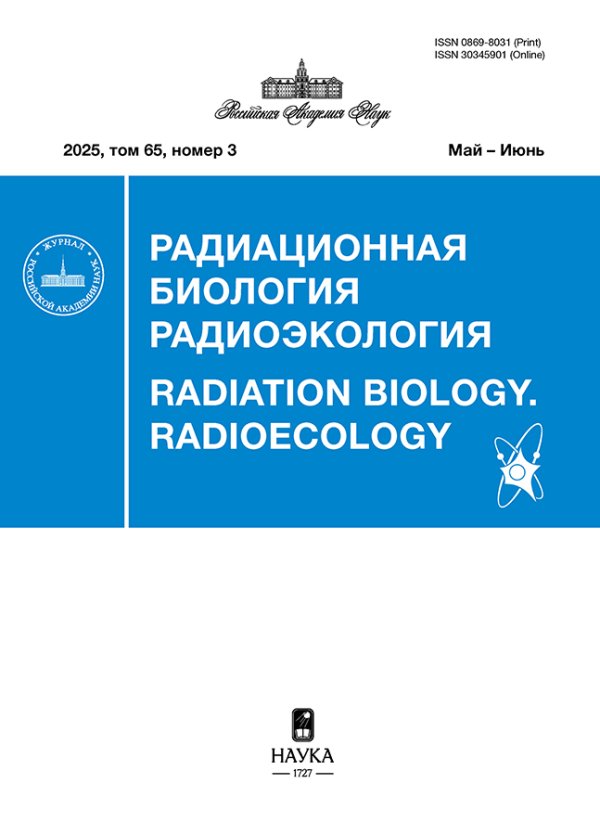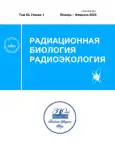Development of shortened recombinant flagellin and study of its radioprotective efficacy in mice with acute radiation injury
- Authors: Murzina E.V.1, Sofronov G.A.1, Simbirtsev A.S.2, Aksenova N.V.1, Klimov N.A.3, Veselova O.M.1, Dmitrieva E.V.1, Kopat V.V.4, Riabchenkova A.A.4, Chirak E.L.4, Chirak E.R.4, Dukhovlinov I.V.4
-
Affiliations:
- Kirov Military Medical Academy
- St. Petersburg Pasteur Research Institute of Epidemiology and Microbiology
- Institute of Experimental Medicine, Saint Petersburg, Russia
- “ATG Service Gene” LLC
- Issue: Vol 65, No 1 (2025)
- Pages: 24–39
- Section: Modification of Radiation Effects
- URL: https://modernonco.orscience.ru/0869-8031/article/view/688223
- DOI: https://doi.org/10.31857/S0869803125010034
- EDN: https://elibrary.ru/KNWTAV
- ID: 688223
Cite item
Abstract
The aim of the work is an experimental study of the radioprotective effect of shortened recombinant flagellin under conditions of total body irradiation of mice by survival rates and the effect on hemo- and immunopoiesis. A new recombinant shortened derivative of Salmonella enterica – dFliC protein obtained by structure-oriented reengineering of a previously developed molecule was used. The radioprotective effect of dFliC was studied in the mouse model of hematopoietic acute radiation syndrome. The 30-day survival of irradiated mice was analyzed using the Kaplan-Meier method. The effect of dFliC protein on the number of splenic colony-forming units (CFU-s) and myelokaryocytes in the bone marrow, peripheral blood parameters, and the cytokine profile in the blood serum of mice was assessed. Statistica 8.0 software was used for statistical processing of the results. A purification test record for the recombinant flagellin dFliC was developed, and protein samples with a purity of 92.79% according to HPLC were obtained. Administration of dFliC at a dose of 1 mg/kg 30 min prior to 7.8 Gy X-rays increased 30-day survival of mice by 38% (p < 0.05 compared to the vehicle control). On day 9 after X-ray irradiation at a dose of 7 Gy, the number of colonies increased 2.8 times in dFliC-treated mice (p < 0.05), the viability of hematopoietic progenitor cells increased and the severity of thrombocytopenia decreased. An increase in the production of cytokines involved in hematopoiesis, IL-3. GM-CSF and IL-12p40, has been recorded. The level of proinflammatory cytokines IL-1β and IL-33 was maintained at a lower level than when exposed to radiation without dFliC. Deimmunization and structural rearrangement of the flagellin molecule did not lead to a decrease in the radioprotective effect of the recombinant protein. Radioprotective efficacy of dFliC is provided by a protective effect on bone marrow hematopoietic cells and stimulation of postradiation restoration of hemo- and immunopoiesis by regulating the expression of cytokines with a wide range of biological activity.
Full Text
About the authors
Elena V. Murzina
Kirov Military Medical Academy
Author for correspondence.
Email: elenmurzina@mail.ru
ORCID iD: 0000-0001-7052-3665
Russian Federation, Saint Petersburg
Genrikh A. Sofronov
Kirov Military Medical Academy
Email: gasofronov@mail.ru
ORCID iD: 0000-0002-8587-1328
Russian Federation, Saint Petersburg
Andrei S. Simbirtsev
St. Petersburg Pasteur Research Institute of Epidemiology and Microbiology
Email: simbas@mail.ru
ORCID iD: 0000-0002-8228-4240
Russian Federation, Saint Petersburg
Natalia V. Aksenova
Kirov Military Medical Academy
Email: nataaks@mail.ru
ORCID iD: 0000-0002-5645-7072
Russian Federation, Saint Petersburg
Nicolay A. Klimov
Institute of Experimental Medicine, Saint Petersburg, Russia
Email: nklimov@mail.ru
ORCID iD: 0000-0002-5243-8085
Russian Federation, Saint Petersburg
Olga M. Veselova
Kirov Military Medical Academy
Email: veselova28@mail.ru
ORCID iD: 0009-0007-9345-1845
Russian Federation, Saint Petersburg
Elena V. Dmitrieva
Kirov Military Medical Academy
Email: ev.dmitrieva@yandex.ru
ORCID iD: 0000-0001-6514-7837
Russian Federation, Saint Petersburg
Vladimir V. Kopat
“ATG Service Gene” LLC
Email: kopat@service-gene.ru
ORCID iD: 0000-0002-6573-6743
Russian Federation, Saint Petersburg
Anastasia A. Riabchenkova
“ATG Service Gene” LLC
Email: riabchenkova@service-gene.ru
ORCID iD: 0000-0002-9973-0753
Russian Federation, Saint Petersburg
Evgenii L. Chirak
“ATG Service Gene” LLC
Email: chirak.evgenii@service-gene.ru
ORCID iD: 0000-0001-9167-5000
Russian Federation, Saint Petersburg
Elizaveta R. Chirak
“ATG Service Gene” LLC
Email: chirak.elizaveta@service-gene.ru
ORCID iD: 0000-0002-1610-8935
Russian Federation, Saint Petersburg
Ilya V. Dukhovlinov
“ATG Service Gene” LLC
Email: atg@service-gene.ru
ORCID iD: 0000-0002-5268-9802
Russian Federation, Saint Petersburg
References
- Tallant T., Deb A., Kar N. et al. A Flagellin acting via TLR5 is the major activator of key signaling pathways leading to NF-kappa B and proinflammatory gene program activation in intestinal epithelial cells. BMC Microbiol. 2004;4:33. https://doi.org/10.1186/1471-2180-4-33
- Rhee S.H., Im E., Pothoulakis C. Toll-like receptor 5 engagement modulates tumor development and growth in a mouse xenograft model of human colon cancer. Gastroenterology. 2008;135(2):518–528. https://doi.org/10.1053/j.gastro.2008.04.022
- Singh V.K., Seed T.M. Entolimod as a radiation countermeasure for acute radiation syndrome. Drug Discov. Today. 2021;26(1):17–30. https://doi.org/10.1016/j.drudis.2020.10.003
- Molofsky A.B., Byrne B.G., Whitfeld N.N. et al. Cytosolic recognition of flagellin by mouse macrophages restricts Legionella pneumophila infection. J. Exp. Med. 2006;203(4):1093–1104. https://doi.org/10.1084/jem.20051659
- Lai L., Yang G., Yao X., Wang L., Zhan Y., Yu M., Yin R., Li C., Yang X, Ge C. NLRC4 mutation in flagellin-derived peptide CBLB502 ligand-binding domain reduces the inflammatory response but not radioprotective activity. J. Radiat. Res. 2019;60(6):780–785. https://doi.org/10.1093/jrr/rrz062
- Biedma M.E., Cayet D., Tabareau J. et al. Recombinant flagellins with deletions in domains D1, D2 and D3: Characterization as novel immunoadjuvants. Vaccine. 2019;37(4):652–663. https://doi.org/10.1016/j.vaccine.2018.12.009
- Malapaka R.R., Adebayo L.O., Tripp B.C. A deletion variant study of the functional role of the Salmonella flagellin hypervariable domain region in motility. J. Mol. Biol. 2007;365(4):1102–1116. https://doi.org/10.1016/j.jmb.2006.10.054
- Mett V., Kurnasov O.V., Bespalov I.A. et al. A deimmunized and pharmacologically optimized Toll-like receptor 5 agonist for therapeutic applications. Commun. Biol. 2021;4(1):466. https://doi.org/10.1038/s42003-021-01978-6
- Rhee J.H., Khim K., Puth S., Choi Y., Lee S.E. Deimmunization of flagellin adjuvant for clinical application. Curr. Opin. Virol. 2023;60:101330. https://doi.org/10.1016/j.coviro.2023.101330
- Zinsli L.V., Stierlin N., Loessner M.J., Schmelcher M. Deimmunization of protein therapeutics – Recent advances in experimental and computational epitope prediction and deletion. Comput. Struct. Biotechnol. J. 2021;19:315–329. https://doi.org/10.1016/j.csbj.2020.12.024
- Гребенюк А.Н., Аксенова Н.В., Петров А.В. и др. Получение различных вариантов рекомбинантного флагеллина и оценка их радиозащитной эффективности. Вестн. Рос. воен.-мед. академии. 2013;3:75–80. [Grebenyuk A.N., Aksenova N.V., Petrov A.V. et al. Poluchenie razlichnykh variantov rekombinantnogo flagellina i otsenka ikh radiozashchitnoy effektivnosti = = Preparation of different recombinant flagellin variants and evaluation of their radioprotective efficacy. Vestnik Rossiyskoy Voenno-meditsinskoy akademii. 2013;3:75–80. (In Russ.)].
- Мурзина Е.В., Софронов Г.А., Аксенова Н.В. и др. Экспериментальная оценка противолучевой эффективности рекомбинантного флагеллина. Вестн. Рос. воен.-мед. академии. 2017;19(3):122–128. [Murzina E.V., Sofronov G.A., Aksenova N.V. et al. Experimental estimation of the radioprotective efficiency of recombinant flagellin. Vestnik Rossijskoj voenno-medicinskoj akademii. 2017;19(3):122–128. (In Russ.)]. https://doi.org/10.17816/brmma623038
- Лисина Н.И., Щеголева Р.А., Шлякова Т.Г. и др. Противолучевая эффективность флагеллина в опытах на мышах. Радиац. биология. Радиоэкология. 2019;59(3):274–278. [Lisina N.I., Shchegoleva R.A., Shlyakova T.G. et al. Evaluation of antiradiation efficiency of flagellin in experiments of mice. Radiacionnaya biologiya. Radioekologiya = = Radiation biology. Radioecology. 2019;59(3):274–278. (In Russ.)]. https://doi.org/10.1134/S086980311903007X
- Wang F., Burrage A.M., Postel S. et al. A structural model of flagellar filament switching across multiple bacterial species. Nat. Commun. 2017;8(1):960. https://doi.org/10.1038/s41467-017-01075-5
- Madeira F., Park Y.M., Lee J. et al. The EMBL-EBI search and sequence analysis tools APIs in 2019. Nucleic Acids Res. 2019;47(W1):636–641. https://doi.org/10.1093/nar/gkz268
- Wilkins M.R., Gasteiger E., Bairoch A. et al. Protein identification and analysis tools on the ExPASy Server. Methods Mol. Biol. 1999:112:531–552. https://doi.org/10.1385/1-59259-584-7:531
- Yang J., Zhang Y. I-TASSER server: new development for protein structure and function predictions. Nucleic Acids Res. 2015;43(W1):174–181. https://doi.org/10.1093/nar/gkv342
- Green M.R., Sambrook J. Transformation of Escherichia coli by electroporation. Cold Spring Harb. Protocols. 2020;2020(6):101220. https://doi.org/10.1101/pdb.prot101220
- Laemmli U.K. Cleavage of structural proteins during the assembly of the head of bacteriophage T4. Nature. 1970;227(5259):680–685. https://doi.org/10.1038/227680a0
- Директива 2010/63/EU Европейского парламента и совета европейского союза по охране животных, используемых в научных целях. Санкт-Петербург: Rus-LASA “НП объединение специалистов по работе с лабораторными животными”, 2012. 48 с. [Directive 2010/63/EU of the European parliament and of the council of 22 September 2010 on the protection of animals used for scientific purposes (Text with EEA relevance). Official J. Europ. Union. 2010:33–79. (In Russ.)].
- Till J.E., McCulloch E.A. A direct measurement of the radiation sensitivity of normal mouse bone marrow cells. 1961. Radiat. Res. 2011;175(2):145–149. https://doi.org/10.1667/rrxx28.1
- Ковальчук Л.В., Игнатьева Г.А., Ганковская Л.В. и др. Иммунология: практикум. М.: ГЭОТАР-Медиа, 2015. 176 с. [Koval’chuk L.V., Ignat’eva G.A., Gankovskaya L.V. i dr. Immunologiya: praktikum = = Immunology: a practical course. Moscow: GEOTAR-Media, 2015. 176 p. (In Russ.)].
- Chen X., Zaro J.L., Shen W.C. Fusion protein linkers: property, design and functionality. Adv. Drug Deliv. Rev. 2013;65(10):1357–1369. https://doi.org/10.1016/j.addr.2012.09.039
- Гребенюк А.Н., Легеза В.И. Противолучевые свойства интерлейкина-1. Санкт-Петербург: Фолиант, 2012. 216 с. [Grebenyuk A.N., Legeza V.I. Protivoluchevye svojstva interlejkina-1 = Antiradiation properties of interleukin-1. Sankt-Peterburg: Foliant, 2012. 216 p. (In Russ.)].
- Schaue D., Kachikwu E.L., McBride W.H. Cytokines in radiobiological responses: a review. Radiat. Res. 2012;178(6):505–523. https://doi.org/10.1667/RR3031.1
- Васин М.В., Соловьев В.Ю., Мальцев В.Н. и др. Первичный радиационный стресс, воспалительная реакция и механизм ранних пострадиационных репаративных процессов в облученных тканях. Мед. радиология и радиац. безопасность. 2018;63(6):71–81. [Vasin M.V., Solov’ev V.Yu., Mal’tsev V.N. et al. Primary radiation stress, inflammatory reaction and the mechanism of early postradiation reparative processes in irradiated tissue. Medical Radiology and Radiation Safety. 2018;63(6):71–81. (In Russ.)]. https://doi.org/10.12737/article_5c0eb50d2316f4.12478307
- Рыбкина В.Л., Азизова Т.В., Адамова Г.В., Ослина Д.С. Влияние ионизирующего излучения на цитокиновый статус (обзор литературы). Радиац. биол. Радиоэкология. 2022;62(6):578–590. [Rybkina V.L., Azizova T.V., Adamova G.V., Oslina D.S. Effect of ionizing radiation on cytokine status (Literature review). Radiacionnaya biologiya. Radioekologiya = = Radiation biology. Radioecology. 2022;62(6):578–590. (In Russ.)]. https://doi.org/10.31857/S086980312206011X
- DiCarlo A.L., Horta Z.P., Aldrich J.T. et al. Use of growth factors and other cytokines for treatment of injuries during a radiation public health emergency. Radiat. Res. 2019;192(1):99–120. https://doi.org/10.1667/RR15363.1
- Симбирцев А.С., Кетлинский С.А. Перспективы использования цитокинов и индукторов синтеза цитокинов в качестве радиозащитных препаратов. Радиац. биология. Радиоэкология. 2019;59(2):170–176. [Simbirtsev A.S., Ketlinsky S.A. Perspectives for cytokines and cytokine synthesis inducers as radioprotectors. Radiacionnaya biologiya. Radioekologiya = Radiation biology. Radioecology. 2019;59(2):170–176. (In Russ.)]. https://doi.org/10.1134/S0869803119020164
- Легеза В.И., Драчев И.С., Чепур С.В. Осложнения лучевой противоопухолевой терапии (клиника, патогенез, профилактика, лечение). Санкт-Петербург: СпецЛит, 2022. 207 с. [Legeza V.I., Drachev I.S., Chepur S.V. Oslozhneniya luchevoj protivoopuholevoj terapii (klinika, patogenez, profilaktika, lechenie) = Complications of radiation antitumor therapy (clinic, pathogenesis, prevention, treatment). Sankt-Peterburg: SpecLit, 2022. 207 p. (In Russ.)].
- Guan R., Pan M., Xu X. et al. Interleukin-33 potentiates TGF-β signaling to regulate intestinal stem cell regeneration after radiation injury. Cell Transplant. 2023;32:9636897231177377. https://doi.org/10.1177/09636897231177377
- Пономарев Д.Б., Степанов А.В., Селезнев А.Б., Ивченко Е.В. Ионизирующие излучения и воспалительная реакция. Механизмы формирования и возможные последствия. Радиац. биология. Радиоэкология. 2023;63(3):270–284. [Ponomarev D.B., Stepanov A.V., Seleznyov A.B., Ivchenko E.V. Ionizing radiation and inflammatory reaction. Formation mechanism and implications. Radiacionnaya biologiya. Radioekologiya = Radiation biology. Radioecology. 2023;63(3):270–284. (In Russ.)]. https://doi.org/10.31857/S0869803123030128
Supplementary files



















